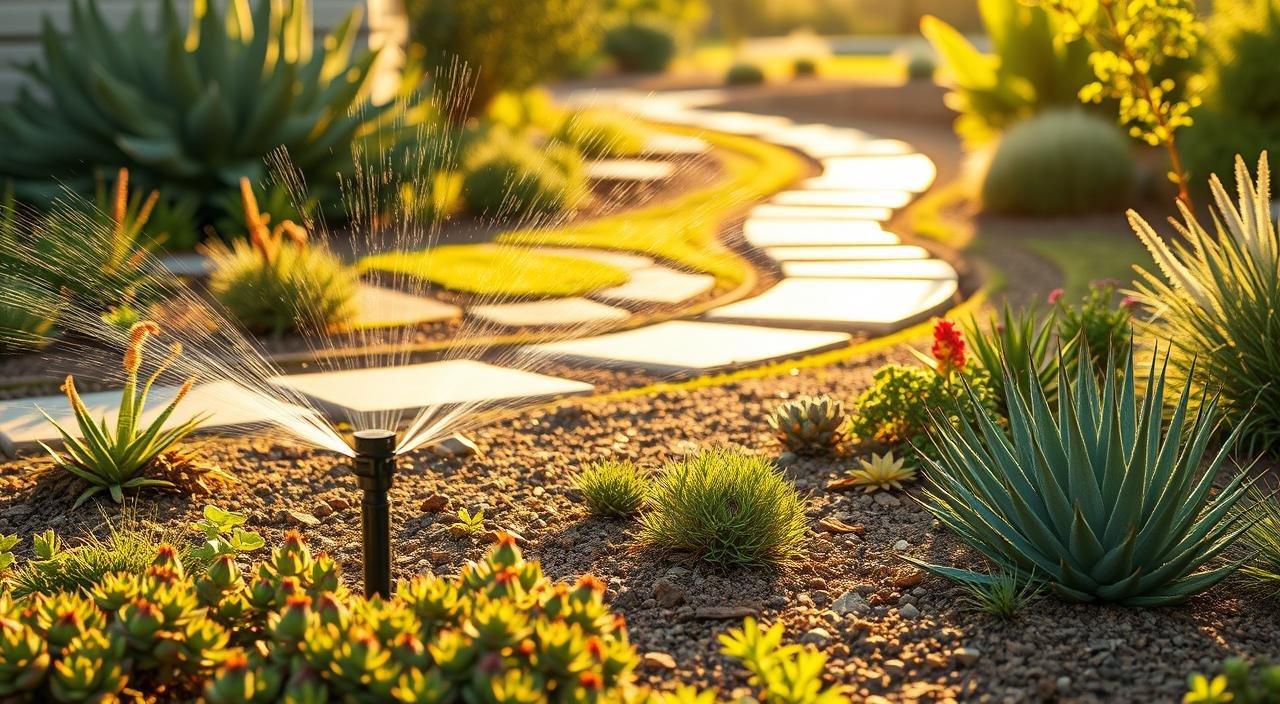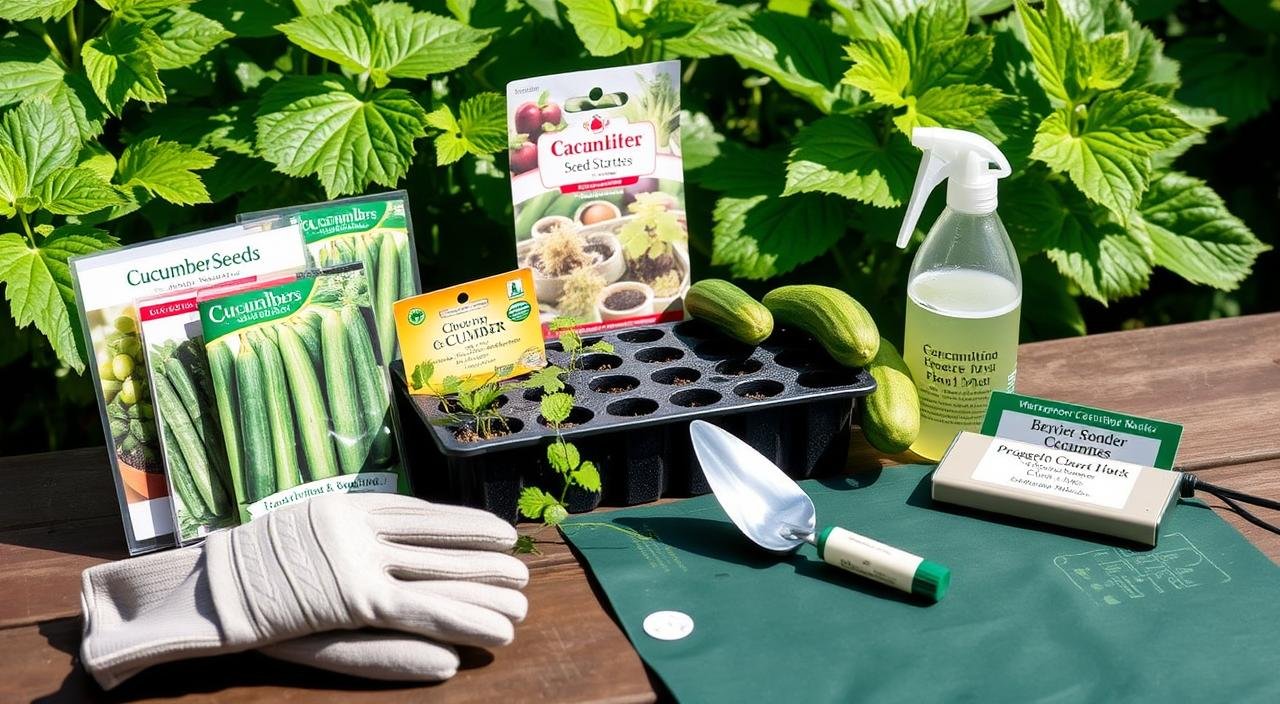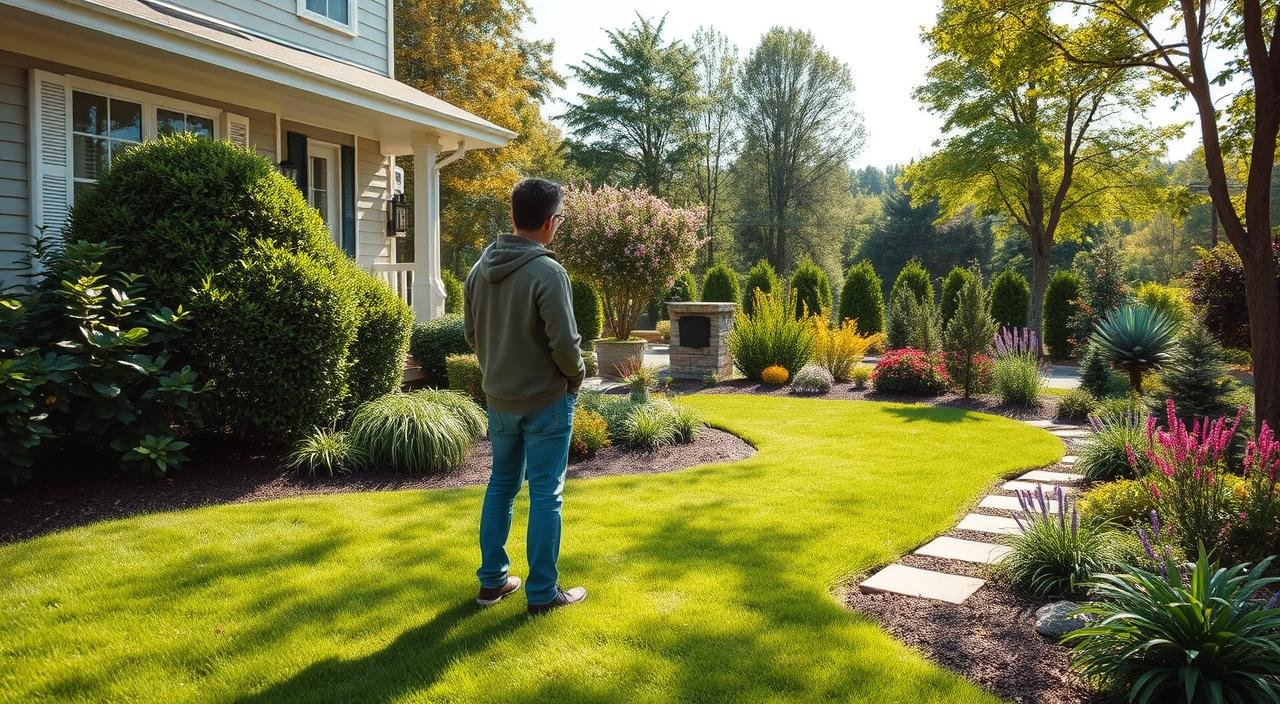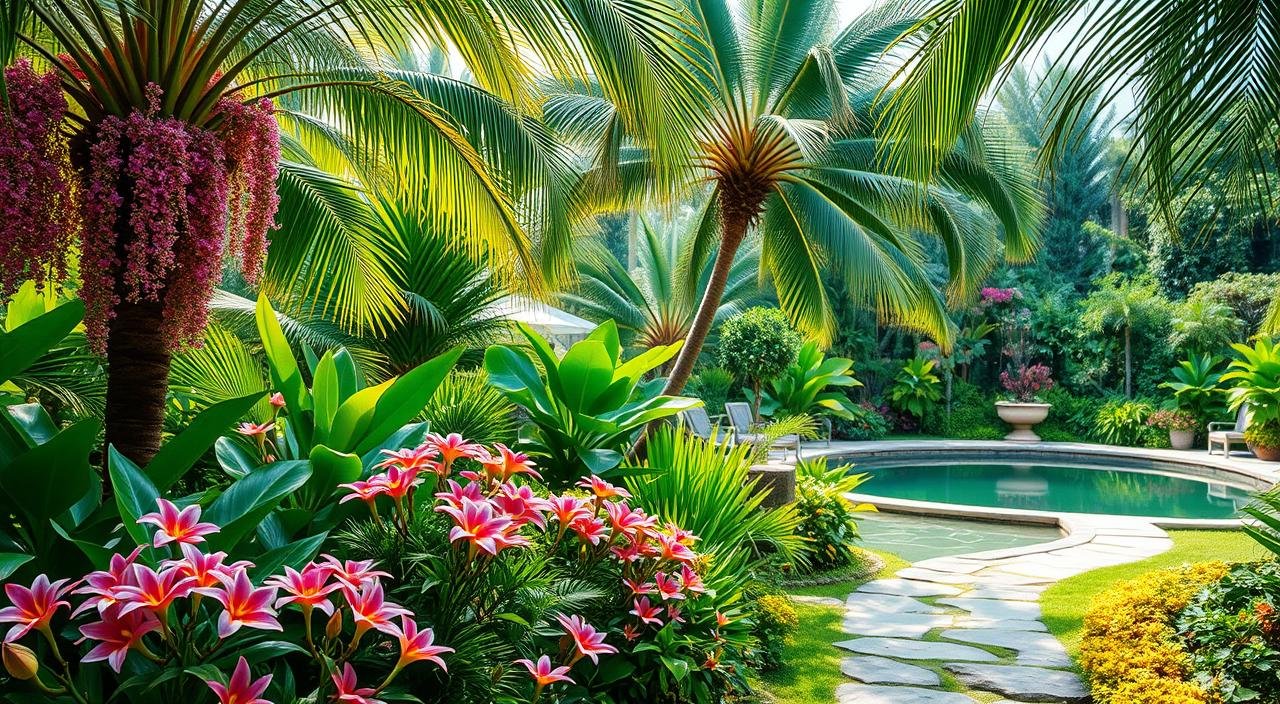Low Maintenance Front Yard: 10 Ideas That Save Time and Effort
Imagine a front yard that looks like it’s straight out of a magazine, all without the need for endless hours of upkeep. If you’ve ever gazed at your lawn and thought, “There must be a better way,” you’re not alone. As a landscape designer with years of experience, I understand the importance of a good first impression. Yet, who wants to spend their weekends tending to it? The truth is, a low maintenance front yard is not just a dream—it’s a reality achievable through smart choices.
Envision a yard that flourishes with minimal effort. Picture replacing water-hungry grass with drought-resistant plants like black-eyed susans or evergreen shrubs that remain vibrant without constant care.
These strategies are not just fantasies; they are the real methods used by professionals to significantly reduce upkeep. Ready to say goodbye to the lawn mower? Let’s explore how to transform your yard into a stunning focal point that enhances your leisure time.
Not sure where to begin? Discover proven lawn maintenance insights that serve as the cornerstone of this approach. The key lies in selecting the right plants and incorporating design elements that harmonize with nature, not against it.
Key Takeaways: low maintenance front yard
- Native plants reduce water use by 50% and cut fertilizer needs
- Hardscaping elements like gravel paths cut mowing time by 70%
- Evergreens provide year-round color with just one annual trim
- Xeriscaping projects start as low as $500 for small spaces
- Container gardens save 90% of traditional lawn watering demands
Why Traditional Front Yards Are High-Maintenance Money Pits
That lush green lawn you’ve been tending isn’t just a hobby—it’s a financial and time drain. Traditional landscaping might look picture-perfect, but the reality? It’s a treadmill of costs and effort. Switching to minimal upkeep landscaping is the smarter choice.
The Hidden Costs of Conventional Landscaping
Numbers don’t lie. Here’s what your wallet loses every year:
| Expense | Annual Cost Range |
|---|---|
| Lawn mowing (if outsourced) | $700–$900 |
| Water overuse | $600–$900 |
| Fertilizers/pesticides | $71–$377 |
| Annual flower replanting | $100–$300 |
Common Time-Consuming Front Yard Elements
Imagine spending 100+ hours yearly on lawn care—time you could spend relaxing in your yard instead of slaving over it! Top offenders include:
- Weekly mowing (72 hours/year alone!)
- Trimming hedges and topiaries
- Watering and weeding daily in summer
Environmental Impact of High-Maintenance Yards
Did you know pesticides from lawns run into rivers and kill pollinators?
Lawns consume 30% of U.S. residential water use—most of it wasted on thirsty grass
(EPA, 2023). Minimal upkeep landscaping uses native plants that thrive without chemicals or excess water. It’s a win for your wallet, schedule, and the planet!
Ready to ditch the guilt and the gas-powered tools? Minimal upkeep landscaping isn’t just a trend—it’s a smart shift toward saving time, money, and the environment. Let’s get to the solutions next—no more “perfect” lawns holding you back!
The Benefits of Creating a Low Maintenance Front Yard
Imagine a front yard that looks sharp without demanding constant attention. A hassle-free front yard isn’t just a dream—it’s achievable! Let’s explore why this approach is a game-changer for homeowners.
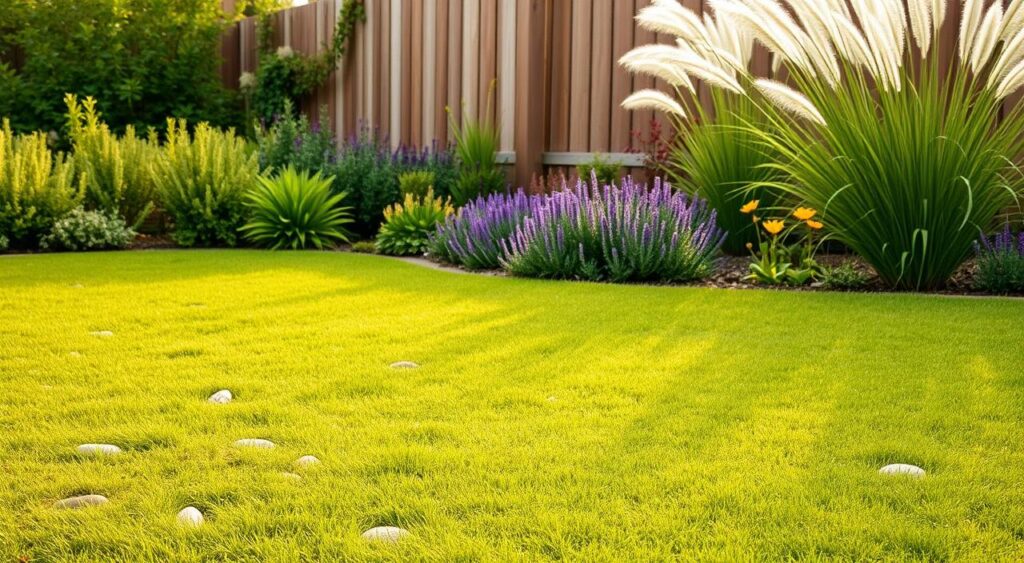
- Time Freedom: Save 10–20 hours monthly by swapping grass for drought-tolerant plants like lavender or succulents.
- Cost Savings: Cut water bills by 30% with drip irrigation and native plants that thrive on local rainfall.
- Earth-Friendly Appeal: Reduce chemical use by 50% with organic pest control and soil-enriching mulch.
- Value Boost: Properties with smart low maintenance designs see a 5–15% increase in curb appeal and resale value.
| Benefit | How It Works |
|---|---|
| Time | Replace mowing with ground covers like creeping thyme or gravel paths. |
| Cost | Native plants like black-eyed susans need no extra watering once established. |
| Planet | Less water waste and chemical runoff protects local ecosystems. |
| Value | Stone pathways or xeriscaping add modern flair without the upkeep. |
“My yard now looks better than ever—and I garden once a week max!” – Sarah, Phoenix homeowner
With smart choices like pavers, drip systems, and native plants, your hassle-free front yard becomes a space that’s both beautiful and stress-free. Ready to reclaim your weekends?
Analyzing Your Space: The First Step to a Low Maintenance Front Yard
Before you start buying plants, take a moment to observe. Your yard’s layout, light, and soil offer clues for a low maintenance landscape. These low maintenance landscaping tips begin with understanding what you already have. Then, you can build upon it.
Assessing Sun Exposure and Microclimates
Take out your phone and a notebook. Record where the sun hits at 8 AM, noon, and 4 PM. Remember, shade patterns change with the seasons. Track these changes. Microclimates, like a north-facing wall versus an open lawn, affect planting zones. Use apps like SunCalc to map out light shifts.
- Take 3 photos daily for a week to spot patterns
- Mark sunny, partial shade, and full shade zones
- Pair plants to zones (e.g., hostas in shade, lavender in sun)
Understanding Your Soil Type and Drainage
Healthy soil is key to healthy plants. Perform a mason jar soil test: mix a soil sample with water, shake, and let settle. The layers will show clay and sand ratios. For drainage, dig a hole, fill with water. If it drains slowly, consider installing French drains or rain gardens.
| Issue | Solution |
|---|---|
| Clay soil | Amend with compost or use raised beds |
| Slow drainage | Install French drains or rain gardens |
| Compacted soil | Add organic mulch annually |
Identifying Problem Areas and Opportunities
Walk your yard like a detective. Note:
- Steep slopes (ideal for terraced gardens)
- Wet spots (perfect for moisture-loving plants)
- High-traffic zones (use gravel instead of grass)
Look for opportunities. Mature trees add instant appeal. A blank wall? Add a vertical garden. Use this low maintenance landscaping tips checklist to prioritize fixes and accentuate strengths. Remember, this step isn’t guesswork. Small tweaks now save hours later. Let’s get started!
Smart Planning: Designing Your Low Maintenance Front Yard Layout
Picture a front yard that’s both elegant and effortless. With easy landscaping ideas, transforming your outdoor space into a serene oasis is achievable. Begin by defining the purpose of your yard. Do you envision a spot for your morning coffee or a path for evening dog walks? Prioritize these needs, as they will influence every design decision. Experts agree that clear planning can reduce future problems by half.
“A well-planned layout is 80% of the battle.”
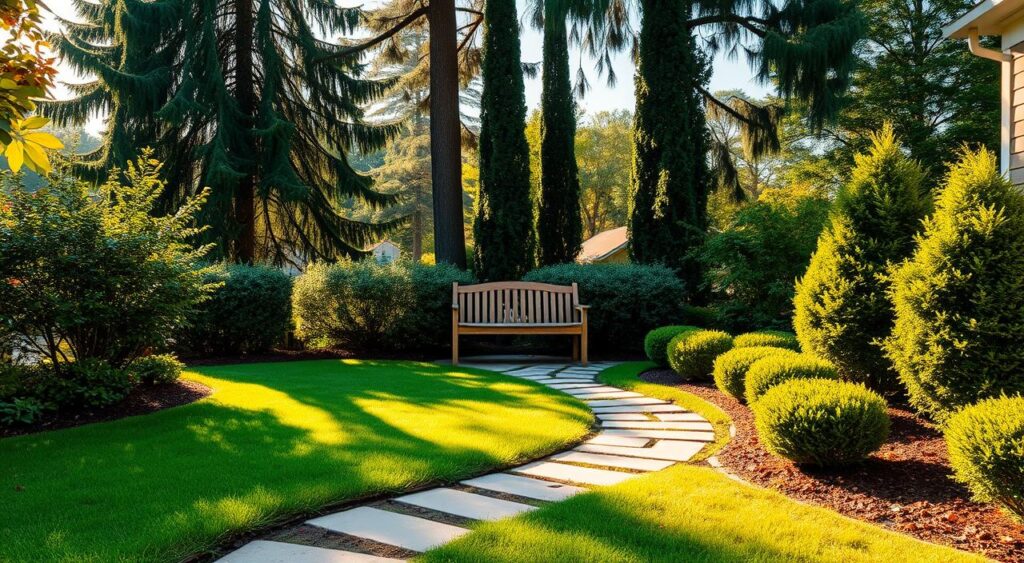
Divide your yard into maintenance zones. Place high-need plants near your home’s entrance for maximum visibility. For areas that require less upkeep, consider replacing grass with clover or thyme, eliminating the need for mowing. Group plants with similar watering requirements to simplify your watering schedule. For instance, pairing a hydrangea with a cactus is not advisable due to their different care needs.
- Visual pop, no sweat: Combine different textures, such as the fuzzy leaves of lamb’s ear with the sleek foliage of boxwoods. Repeating a single flower type, like lavender, creates a cohesive look without the complexity.
- Scale matters: Ensure a 3–5 feet gap between shrubs to prevent overcrowding. Overplanting necessitates excessive pruning. Sketching your design on paper beforehand can help avoid 30% of common mistakes.
Design with a professional mindset. Opt for gravel pathways and drought-resistant plants like coneflowers or black-eyed Susans. Each decision should balance aesthetics with practicality. Ready to embark on your design journey? Begin with your prioritized list, and your future self will appreciate the effort.
Drought-Tolerant Plants That Thrive With Minimal Care
Let’s cut to the chase: the right drought-tolerant plants slash your workload and water use while adding serious curb appeal. These aren’t just “survivors”—they’re landscape MVPs that bloom, sway, and stand strong even when you forget to water. Here’s your cheat sheet:
- Lantana: Bold bursts of red, pink, or orange flowers. Thrives in sun, blooms nonstop, and loves Zones 9-11. Bonus: butterflies flock to it!
- Coneflower (Echinacea): Rustic perennials that bloom in zones 3-8. Perfect for poor soil—just plant and watch bees flock in.
- Pink Muhly Grass: Cloud-like pink plumes in fall. Grows in zones 5-11. No fall cleanup needed—leave it standing for winter texture.
- Coreopsis: Sunshine-yellow blooms that shine in zones 4-9. Deer ignore it, and it blooms for months without deadheading.
- Russian Sage (Perovskia: Silvery stems and purple flowers. Zones 3-9. Needs zero winter protection and repels deer.
- Black-Eyed Susan: Golden petals with dark centers. Zones 3-9. Survives drought and feeds birds in fall.
Pro move: Skip “drought-tolerant” plants that demand constant trimming (like invasive varieties). Stick to zone-matched picks. For example, lavender’s fragrant blooms adore well-drained soil but drown in heavy clay. Pair with gravel mulch for instant Southwest vibes!
These plants aren’t just survivors—they’re style stars. Pick three or four to anchor your beds, and watch your yard become a pollinator hotspot without daily tending. Your future self will thank you.
Native Plants: The Ultimate Low-Effort, High-Impact Choice
Imagine a front yard that blooms effortlessly. This is the beauty of native plants. They’re designed to thrive in your local climate and soil. By choosing native species, you’re not only reducing work but also creating a harmonious landscape with nature.
Sustainable front yard design is all about finding this balance. It’s where beauty and practicality come together seamlessly.
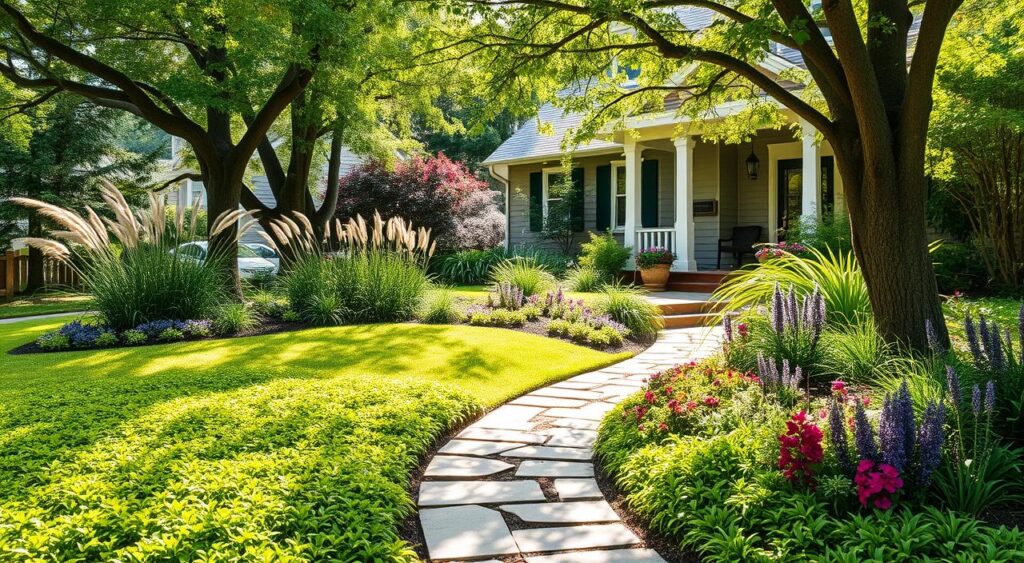
Let’s get specific! Match your region with plants that were born to shine there:
List of styles to help you
- Northeast: Try columbine or lupine for spring pops of color.
- Southeast: Eastern rose-mallow and pink muhly grass thrive in humid climates.
- Midwest: Ox-eye sunflower and black-eyed Susan stand up to heat and drought.
- Pacific Northwest: Moist-soil lovers like turtlehead and heather fit perfectly.
Swap sterile lawns for life! Plants like elderberry and blueberry don’t just look good—they feed birds and pollinators. Golden Alexander attracts butterflies, while bee balm hums with bees and hummingbirds. Your yard becomes a mini-ecosystem that nourishes life without extra effort.
Why rotate plants when natives do the work for you? Pair spring-blooming yarrow with fall’s giant plume grass for year-round drama. Winter stems of aster or coneflower add texture, while spring’s new growth starts naturally. Less pruning, more enjoying!
Think of native plants as your climate’s secret weapon. They’re the backbone of sustainable front yard design—proven to reduce water use by up to 50% compared to non-native options. Start small—swap one non-native shrub for a wild ginger groundcover. Watch your space transform into a low-effort, high-impact space that’s as smart as it is beautiful.
Hardscaping Elements That Reduce Maintenance Requirements
Imagine a front yard that remains stunning without constant upkeep—that’s the magic of smart hardscaping. By replacing grass with durable surfaces, you significantly reduce water use and weed battles. This also enhances curb appeal. Let’s dive into how these elements transform your space into an eco-friendly front yard that requires minimal effort.
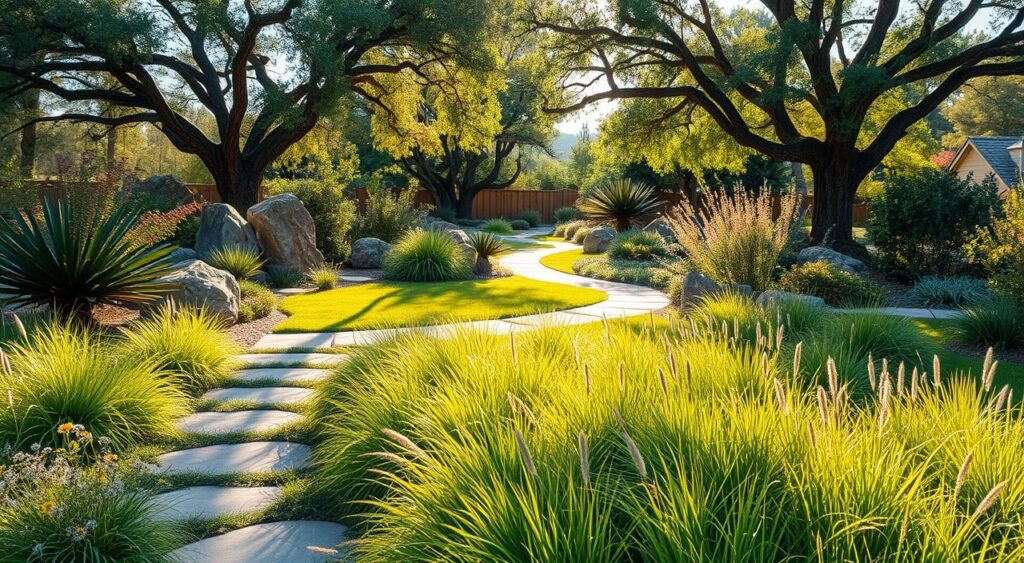
Patios, Walkways, and Other Hard Surfaces
Begin by swapping high-maintenance grass for permeable pavers or decomposed granite paths. These options drastically cut down on mowing and watering needs. They also allow rainwater to filter naturally. Choose recycled materials like crushed concrete or FSC-certified wood—such as reclaimed cedar—for an eco-friendly front yard. A pro tip: Arrange pavers in a grid pattern for easier cleaning and better drainage!
Decorative Rocks and Gravel Installations
Gravel and river rock are transformative. Use them in garden beds to suppress weeds and retain soil moisture—no need for annual mulch! Dark volcanic rock adds contrast, while light pebbles offer a modern look. Plus, stones won’t be swept away like straw mulch, saving you time and money.
Low Maintenance Border Solutions
Sharp lines mean less mess. Install plastic or metal edging to keep gravel in place and grass out. Natural stone borders, such as river boulders or stacked fieldstone, bring rustic charm while blocking invasive weeds. For a modern touch, consider pre-formed concrete curbs. These borders greatly reduce weekly trimming and manual weeding.
Water-Wise Irrigation Systems for Effortless Plant Care
Smart watering is all about strategic water use in low water landscaping. Drip irrigation systems revolutionize watering by delivering water directly to the roots. This method significantly reduces evaporation, saving both time and money. Here’s how to implement it effectively:
- Install rain or soil moisture sensors to stop overwatering—saves 20-30% in water use.
- Test sprinkler output with cans: place 6 cans, run the system 20 mins, measure depth. Adjust to avoid runoff!
- Pair drip systems with mulch—2-3” thick layers retain moisture and block weeds.
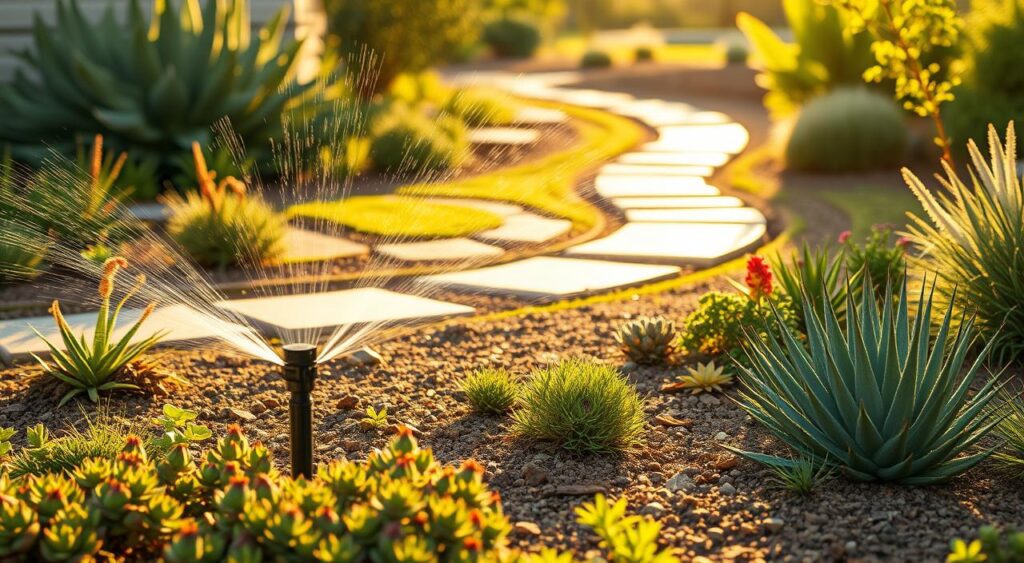
| System | Efficiency | Water Use | Best For |
|---|---|---|---|
| Drip Irrigation | 90% | 0.5-4 GPH | Flowerbeds, shrubs |
| Smart Sprinklers | 70% | 1-3 GPM | Lawns with sensors |
| Soaker Hoses | 85% | 1-2 GPH | Narrow garden beds |
“Water deeply but infrequently—soil should soak 1-3 feet deep depending on plant size.” – EPA WaterSense Guide
Hydrozoning is essential: group plants by their water needs. This ensures each zone receives the right amount of water. Follow the 1-2-3 Rule for watering: 1’ deep for annuals, 2’ for shrubs, and 3’ for trees. Use timers for automation but regularly inspect for leaks. Small fixes today lead to significant savings tomorrow, benefiting your plants greatly!
Mulching Techniques to Minimize Weeding and Water Loss
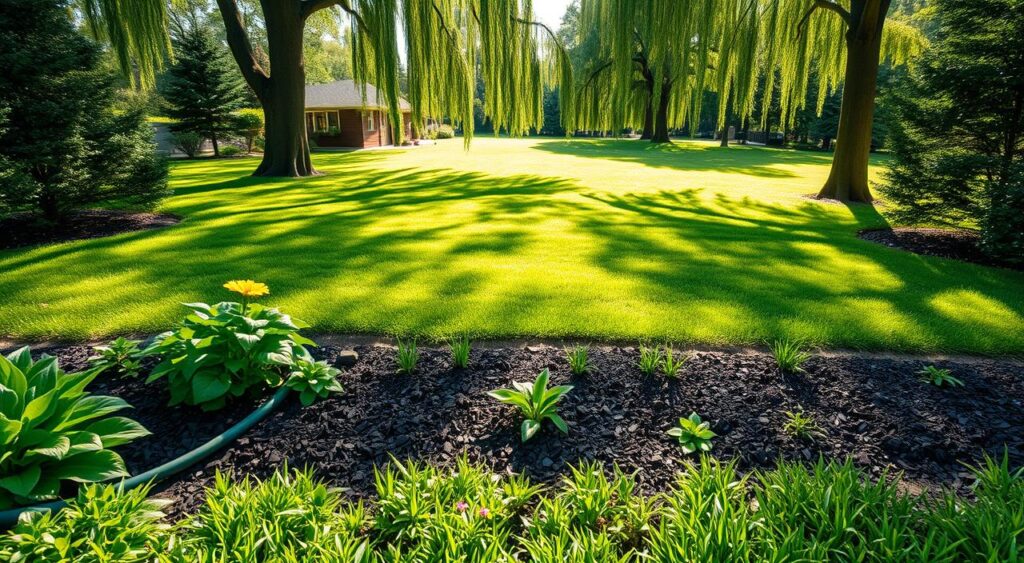
Imagine a garden that stays lush without daily battles with weeds or constant watering. That’s where mulch steps in! A 2-3 inch layer acts like armor for your soil—locking in moisture, blocking weeds, and protecting roots. This simple garden maintenance trick is your secret weapon for a yard that thrives with minimal effort.
| Type | Pros | Cons |
|---|---|---|
| Organic (compost, bark) | Nutrient boost, breaks down naturally | Needs replacing yearly |
| Inorganic (gravel, rubber) | Long-lasting, low replacement | Doesn’t improve soil, may overheat soil |
Pro tip: Avoid “mulch volcanoes” around trees! Leave 6 inches clear around trunks to prevent rot. Here’s how to apply it right:
- Clear debris and weeds before laying mulch
- Spread 2-3 inches thick—thicker than that blocks water absorption
- Keep mulch 12 inches away from house foundations to prevent pests
Going green? Try these sustainable swaps:
- Grind fallen leaves into winter mulch
- Reuse pine needles for acidic-loving plants
- Layer old newspapers under mulch to smother weeds
With these tricks, mulching becomes your ultimate time-saver. Let me know—what’s your favorite mulch material? 🌱
Simple Substitutions for High-Maintenance Front Yard Features
Ready to trade tedious chores for smart upgrades? Let’s swap your high-maintenance features for options that save time without sacrificing style. Here’s how to rethink your space:
- Grass → Hardscape: Replace 30-50% of your lawn with patios or walkways. Stone or pavers add seating areas while slashing mowing time by 50%.
- Weeds → Gravel Gardens: Swap mulch beds with decorative gravel. It blocks weeds, needs zero watering, and lasts decades—think crushed granite or river rock.
- Annuals → Perennials: Choose native flowers like lavender or sedum. They bloom yearly with zero replanting—hello, low maintenance front yard charm!
- Fence → Living Privacy Screens: Plant shrubs like boxwood or bamboo instead of wooden fences. They grow tall, block views, and require pruning just once yearly.
“Hardscapes reduce water use by 60% and save 20+ hours monthly compared to lawns.” – Sustainable Landscaping Report 2023
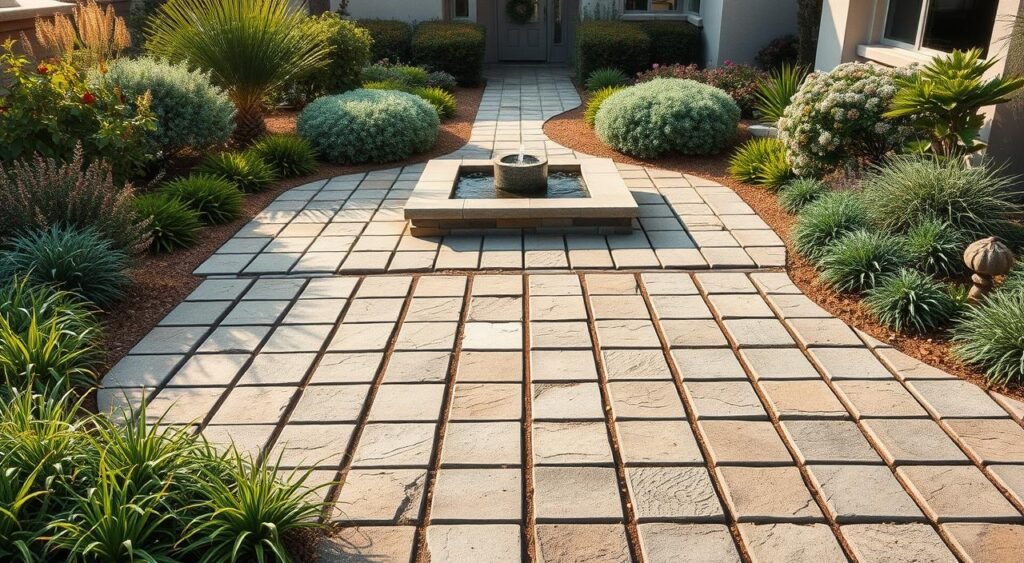
Think of these swaps as upgrades, not losses. A stone path here, a cluster of native grasses there—you’ll have curb appeal with 80% less work. Need a focal point? Try a fire pit surrounded by river rock. Want color? Mix drought-tolerant succulents with flagstone borders. Every choice moves you closer to a yard that looks great while giving you back weekends. Ready to start? Swap one area at a time and watch the stress vanish.
Seasonal Maintenance Schedule for Your Low Maintenance Front Yard

While no landscape is completely effortless, smart strategies can make upkeep minimal. These low maintenance landscaping tips transform seasonal care into quick, efficient routines. They fit seamlessly into your busy schedule.
Spring Checklist: Setting Up for Success
- Trim dead branches and shape shrubs before new growth starts
- Mulch beds with 2-3” of shredded bark to suppress weeds
- Plant cool-season flowers like pansies or snapdragons for instant color
- Feed lawns with slow-release fertilizer for steady green growth
Summer and Fall Quick-Care Routines
Stay ahead with these monthly must-dos:
- Water deeply early morning to reduce evaporation
- Deadhead spent blooms on hydrangeas and roses to keep plants tidy
- Rake fallen leaves weekly to prevent mold on grass
- Inspect irrigation systems—fix leaks and adjust sprinkler coverage
Winter Preparation with Minimal Effort
Protect your investment with these final steps:
- Wrap delicate shrubs in burlap, not plastic
- Sharpen tools and store hoses indoors to prevent freezing
- Apply a light layer of compost around perennials for winter insulation
- Check tree stakes and loosen ties that may girdle trunks
By following this calendar, your yard stays in top shape without requiring constant attention. These low maintenance landscaping tips are your secret weapons. Focus on timing, tool prep, and proactive care. Your future self will appreciate the minimal effort come springtime!
Common Mistakes to Avoid When Creating an Easy-Care Landscape
Let’s cut to the chase—easy landscaping ideas only work when you sidestep these hidden traps. I’ve seen even the most thoughtful plans go sideways because of overlooked details. Let’s spotlight the top missteps to eliminate frustration from day one.
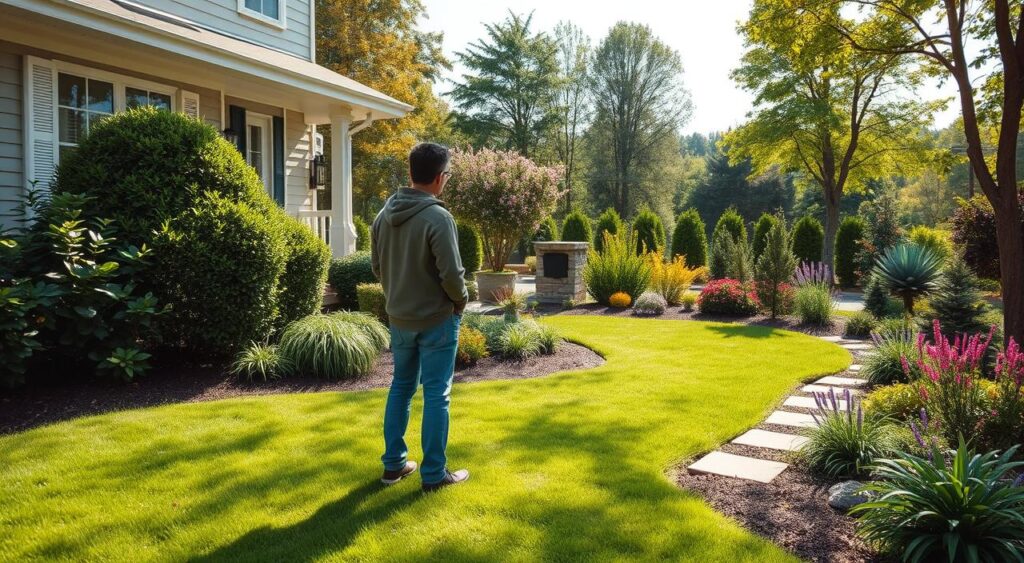
- Overplanting now, crying later: Piling in too many plants creates chaos. Space for growth—check mature sizes before planting! Shrubs that crowd walkways turn into yearly pruning nightmares.
- Ignoring soil secrets: Soil is your foundation. Neglecting to amend it leads to weak plants that demand extra water and fertilizer. Test soil first—this step saves time and cash long-term.
- Choosing “quick fix” materials: Plastic edging? It cracks, peeks above ground, and looks tacky. Swap to stone or pavers for clean lines that last decades, not seasons.
- Planting trees too close to structures: Roots near foundations crack walls. Give trees 10–15 feet from buildings—future-you will thank me.
- Seasonal gaps in color: Mix blooms for year-round interest. Pair spring-blooming bulbs with evergreens and fall foliage. No dead zones means no “meh” moments.
Remember: easy landscaping ideas thrive on foresight. Think ahead about how each element interacts. Swap impulse buys for intentional choices—like replacing grass strips with mulched beds to slash mowing time. Avoid “cheap” materials that cost more in repairs. Your front yard deserves to look great without daily babysitting. Stay smart, stay strategic, and watch your yard evolve into a hassle-free masterpiece.
Conclusion: Enjoy Your Beautiful Front Yard Without the Constant Work
Imagine a front yard that’s always vibrant, yet doesn’t require your weekends. A rain garden or drought-tolerant plants like thyme can reduce watering by half. Mulch or gravel naturally cuts weeds while keeping soil moist. Hardscaping with pavers or rock gardens adds style effortlessly. Beauty doesn’t have to mean endless labor.
Begin with small changes. Replace a grass patch with ground cover or a mulched bed. Focus on plants that excel in your climate zone. Regular checks for pests or leaks save time in the long run. Each decision you make today contributes to a space that grows with you, not against you.
Your front yard should be a source of pride, not stress. Whether you’re planting native flowers or laying stone pathways, these steps create a hassle-free area. Picture enjoying a quiet morning instead of mowing—your future self will appreciate it. Ready? Let your landscape work for you, not the other way around.
FAQ
What are the benefits of a low maintenance front yard?
How do I determine my front yard’s sunlight conditions?
What are some effective drought-tolerant plants for my landscape?
Why should I consider native plants for my landscaping?
How can hardscaping elements help reduce yard maintenance?
What irrigation systems are best for low water landscaping?
How do I properly mulch my garden for the best results?
What common mistakes should I avoid when creating a low maintenance yard?

AUTHOR: MARIA JOSE VENTRAMELI
Specialist in Home Design, Architecture, and Trends
With years of experience writing for top home and lifestyle blogs, she now contributes to 17Vibes, offering practical, research-backed insights on renovations, smart technology, sustainable building, and modern living trends. Join our Facebook community here
